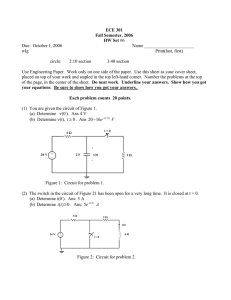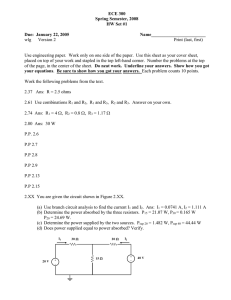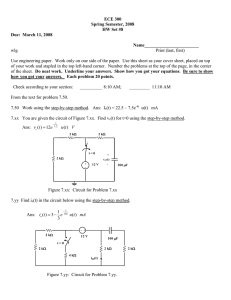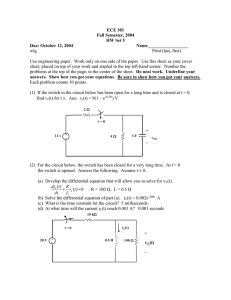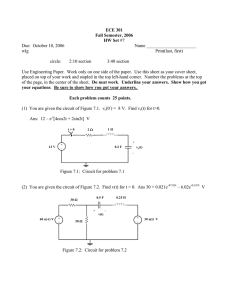Electric Circuits - Assam Valley School
advertisement
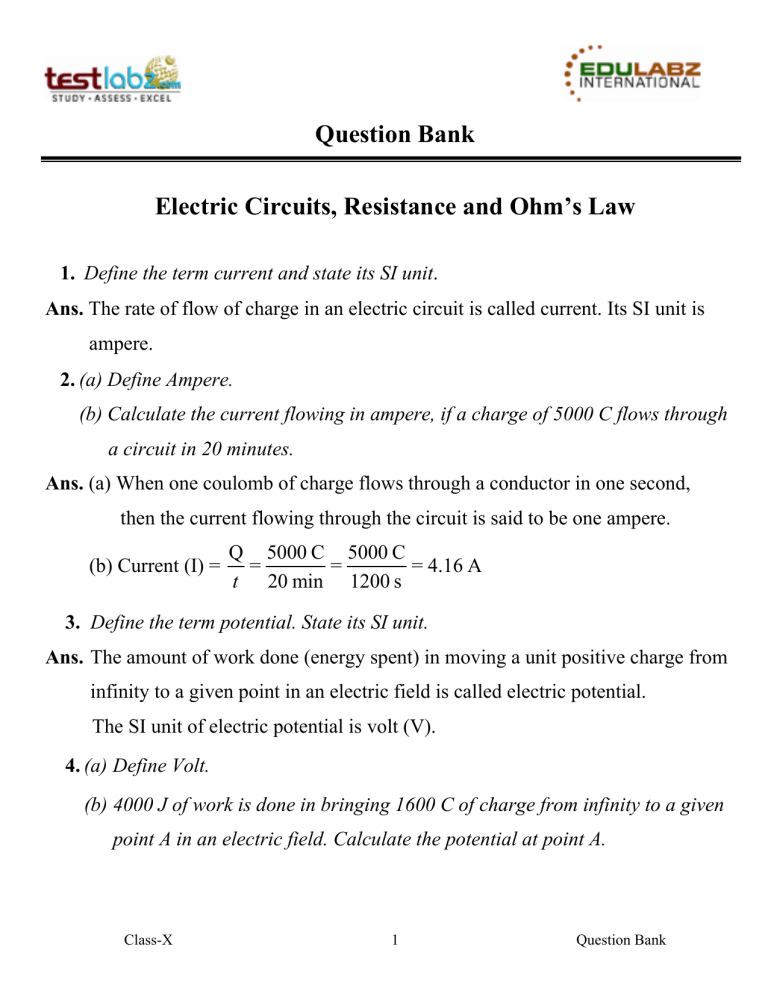
Question Bank Electric Circuits, Resistance and Ohm’s Law 1. Define the term current and state its SI unit. Ans. The rate of flow of charge in an electric circuit is called current. Its SI unit is ampere. 2. (a) Define Ampere. (b) Calculate the current flowing in ampere, if a charge of 5000 C flows through a circuit in 20 minutes. Ans. (a) When one coulomb of charge flows through a conductor in one second, then the current flowing through the circuit is said to be one ampere. (b) Current (I) = Q 5000 C 5000 C = = = 4.16 A t 20 min 1200 s 3. Define the term potential. State its SI unit. Ans. The amount of work done (energy spent) in moving a unit positive charge from infinity to a given point in an electric field is called electric potential. The SI unit of electric potential is volt (V). 4. (a) Define Volt. (b) 4000 J of work is done in bringing 1600 C of charge from infinity to a given point A in an electric field. Calculate the potential at point A. Class-X 1 Question Bank Ans. (a) When one coulomb electric charge is brought from infinity to a given point in an electric field, such that work done is 1 joule, then the electric potential at that point is one volt. (b)Electric potential = Work done 4000 J = = 2.5 V Charge 1600 C 5. How is potential difference between two points defined? State its SI unit. Ans. The amount of work done in moving a unit charge (say positive) from one point to another point in an electric field is called potential difference (p.d.). Unit of potential difference in SI system is volt (V). 6. Explain the statement “the potential difference between two points is 1 volt.” Ans. From the above statement it implies that when a unit charge (1 coulomb) is moved between the two points in an electric field then the amount of work done is one joule. 7. (a) Define the term electric resistance and state its practical unit. (b) Define the unit of resistance named in (a). (c) How does the resistance of following conductors change with the rise in temperature? (1) Tungsten wire, (2) German silver, (3) Carbon rod. Ans. (a) The opposition offered by a conductor, to the passage of drifting electrons is called electric resistance. Its practical unit is ohm. (b) When a current of 1A flows through a conductor, whose ends are maintained at a p.d. of 1 volt, then the resistance of conductor is one ohm. (c) (1) The resistance of tungsten increases with the rise in temperature. (2) The resistance of German silver does not increase appreciably with the rise in temperature. (3) The resistance of carbon rod decreases with the rise in temperature. Class-X 2 Question Bank 8. State laws of electric resistance and write an expression in terms of length and area of cross-section. Ans. (i) The resistance of a conductor is directly proportional to length. (ii) The resistance of a conductor is inversely proportional to its area of crosssection. Expression : R = l , where ρ is the specific resistance of a conductor. a 9. (a) What do you understand by the term specific resistance ? (b) What is the effect on specific resistance with the change in temperature ? (c) State the SI unit of specific resistance. Ans. (a) The resistance offered by a conductor of unit length and unit area of crosssection, such that the current enters and leaves the conductor from its opposite faces, is called specific resistance. (b) The specific resistance does not change with the rise in temperature. (c) The SI unit of specific resistance is ohm-metre (Ω-m). 10. State two differences between resistance and specific resistance. Ans.(i) The resistance of conductor changes with the change in length, area of crosssection, temperature, etc, but the specific resistance of a conductor is a constant quantity. (ii) The resistance is measured in ohm, whereas specific resistance is measured in ohm-m. Class-X 3 Question Bank 11. Two wires, one of copper and other of iron have same length and same radius. Which wire has more resistance? Ans. Iron wire will have more resistance than copper wire, because the specific resistance of iron wire is more than copper wire. 12. (a) What do you understand by terms : (i) Electric circuit, (ii) Series circuit? (b) State three characteristics of series circuit. Ans. (a) (i) A continuous conducting path, between the terminals of source of electricity (such as cell or battery) is called electric circuit. (ii) When a number of resistors are connected end to end, such that tail of one resistor is connected to initial end of other resistor, so as to form closed electrical circuit, then such a circuit is called series circuit. (b)(i) The current in series circuit is a constant quantity. (ii) There is a continuous drop in potential all along in series circuit, but potential difference goes on increasing. (iii) Total p.d in series circuit is equal to the sum total of p.d across the terminals of individual resistors : V = V1 + V2 + V3. Class-X 4 Question Bank 13. What do you understand by the term parallel circuit ? State its three characteristics. Ans. When a number of resistors are connected such that they have a common positive and a common negative terminal, then resistors are said to be in parallel circuit. (a) The p.d. in a parallel circuit is a constant quantity. (b) The current divides in parallel circuit in the inverse ratio of the resistances. (c) Total current flowing through a parallel circuit is equal to the sum total of current flowing through the individual resistors. I = I1 + I2 + I3. 14. State Ohm’s law. Ans. Ohm’s Law : All physical conditions of a conductor remaining the same, the current flowing through it is directly proportional to potential difference at its ends. 15. Draw a neat circuit diagram for the verification of Ohm’s law by voltmeterammeter method. By another diagram show the relation between p.d. and current. Ans. Class-X 5 Question Bank 16. Draw a neat diagram for the verification of Ohm’s law by potentiometer method. Show the relation between p.d. and the length of conductor. Ans. 17. (a) What do you understand by the term ohmic resistance ? Give two examples. (b) What do you understand by the term non-ohmic resistance ? Give two examples. Ans. (a) A resistor, which obeys Ohm’s law, is said to have ohmic resistance. Examples : Tungsten filament; nichrome wire. (b) A resistor, which does not obey Ohm’s law, is said to have non-ohmic resistance. Examples : Electronic valve; armature of electric motor. Class-X 6 Question Bank 18. Which amongst the following is an ohmic resistance? (i) Diode, (ii) Diamond, (iii) Germanium and (iv) Nichrome. Ans. Nichrome is an ohmic resistance. 19. Figures (a), (b), (c) and (d) below shows I–V characteristic curves for same resistors. Identify the ohmic and non-ohmic resistors and give a reason for your answer. Ans.(a), (b) an (c) are non-ohmic resistors. It is because the V ∝ I as the curves are not a straight line. (d) is an ohmic resistance as V ∝ I and the curve is a straight line. 20. Write an expression connecting the resistance and resistivity. State the meaning of symbols used. Ans. R = ρ. l a ‘R’ is resistance in ohm, ‘ ρ ’ is the resistivity (sp. resistance) of conductor, ‘l’ is the length of the conductor and ‘a’ the area of cross-section of the conductor. 21. State the S.I. unit of resistivity (sp. resistance). Ans. The SI unit of resistivity is ohm-metre ( Ω -m). Class-X 7 Question Bank 22. State the order of resistivity of : (i) metals, (ii) semi-conductors and (iii) insulators. Ans. The order of resistivity of metals is of the order of 10–8 ohm-metre. The order of resistivity of semiconductors is of the order of 10–5 ohm-metre. The order of resistivity of insulators is of the order of 108 to 1016 ohm-metre. 23. Two wires of same material and same length have radii r1 and r2 respectively. Compare their (a) resistances, (b) resistivities. Ans. (i) The resistance of wire ∝ ∝ 1 Area of cross-section 1 (Radius) 2 ∴ resistance of wires will be in the ratio of r22 : r12 (ii) As the material of the wires does not change, therefore, specific resistance does not change. Ratio of resistivities of the wire will be 1 : 1. 24. A given wire is stretched to double its length. How will its resistance change? Give a reason for your answer. Ans. As the length of wire doubles the area of the wire becomes half. Now, the resistance of wire is inversely proportional to the square of the radius, therefore, the resistance will increase four times. Class-X 8 Question Bank 25. Name the material used for making the connection wires. Give a reason for your answer. Ans. Copper is the material commonly used for making connection wires on account of its very low specific resistance. 26. Name the material used for making standard resistors. Give a reason for your answer. Ans. Constantan or Eureka is used for making standard resistors. It is because, these materials offer appreciable amount of resistance, which does not change with the moderate rise in temperature. 27. What is a super conductor? Give two examples. Ans. A material which does not offer any electrical resistance when cooled below certain temperature, is called super conductor. Examples : (1) Mercury when cooled below 4.2 K, becomes super conductor. (2) Ceramic materials containing small amount of lanthanium and barium becomes super conductor, when cooled below 35 K. 28. (a) What do you understand by the term internal resistance of cell ? (b) How is internal resistance of cell affected with change in (i) surface area of electrodes in contact with electrolyte ? (ii) distance between the electrodes ? (iii) concentration of electrolyte ? (iv) temperature of electrolyte ? Class-X 9 Question Bank Ans. (a) The resistance offered by the electrolyte of a cell is called internal resistance. (b) (i) The internal resistance of cell is inversely proportional to the surface area of electrodes in contact with electrolyte. (ii) The internal resistance of cell is directly proportional to the distance between electrodes. (iii) The internal resistance of cell increases with the concentration of electrolyte. (iv) The internal resistance of cell decreases with the rise in temperature. 29. Explain the meaning of terms e.m.f. and terminal voltage of a cell. Ans. e.m.f. : When no current is drawn from the cell, i.e., when the cell is in open circuit, the potential difference between its terminals is called e.m.f. Terminal Voltage : When the current is drawn from a cell, i.e., when the cell is in closed circuit, the potential difference between its terminals is called terminal voltage. 30. A high resistance voltmeter is connected in parallel to the terminals of cell which shows emf E. The cell is connected to an external circuit through a switch and rehostat. When the current in the external circuit is gradually increased, the reading of voltmeter drops. Explain. Ans. Drop in potential is given by the expression : Drop in potential = (E – V) = Ir. Now as the magnitude of I increases, so does the expression Ir. Thus, the drop in potential also increases. This results in the drop in reading in voltmeter. Class-X 10 Question Bank 31. Differentiate between e.m.f. and terminal voltage of a cell. e.m.f. of cell Terminal voltage of cell 1. It is the measure of amount of work 1. It is the measure of amount of work done in moving a unit positive charge done in moving a unit positive charge in an electrical circuit, outside the cell in a complete electrical circuit, inside 2. It depends upon the amount of current and outside the cell. drawn from the cell. More is the current 2. It is the characteristic of the cell i.e., it does not depend on the amount of drawn from the cell, less is the terminal current drawn from the cell. voltage. 3. It is a constant quantity for a given 3. It is a variable quantity and depends cell. upon the external resistance. Class-X 11 Question Bank Numerical Problems. 1. A wire of resistance 4.5 Ω and length 1.5 m has area of cross-section of 0.04 cm2. Calculate the specific resistance of wire. Ans. R = 4.5 Ω; l = 1.5 m = 150 cm; a = 0.04 cm2; ρ = ? ρ= Ra 4.5 × 0.04 = = 0.0012 Ω cm. . l 150 2. A wire of length 40 cm and area of cross-section 0.1 mm2 has a resistance of 0.8 Ω. Calculate the specific resistance of the wire. Ans. l = 40 cm; a = 0.1 mm2 = 0.001 cm2; R = 0.8 Ω; ρ = ? ρ= Ra 0.8 × 0.001 = 0.00002 Ω cm. = l 40 3. A conductor of length 85 cm has a resistance of 3.75 Ω. Calculate the resistance of a similar conductor of length 540 cm. Ans. l1 = 85 cm; R1 = 3.75 Ω; l2 = 540 cm; R2 = ? R1 l1 R l = ∴R2 = 1 2 R 2 l2 l1 ∴ R2 = 3.75 × 540 = 23.82 Ω. 85 Class-X 12 Question Bank 4. A resistance wire made of German silver has resistance of 4.25 Ω. Calculate the resistance of another wire made from the same material, such that its length increases four times and the area of cross-section decreases three times. Ans.Case (i) : Let l be the length of wire and ‘a’ the area of cross-section ∴R= ρ l ρl or 4.25 = a a …(i) Case (ii) : Length of wire = 4l; area of cross-section of wire = ∴ R1 = ρ 4l a/3 or R1 = ρ 12 ρ l a a 3 …(ii) Dividing (ii) by (i) R1 12 ρ l a = × 4.25 a ρl ∴ R1 = 12 × 4.25 = 51 Ω. 5. (a) A metallic wire has a resistance of 2 ohms per metre. Find the total resistance of two lengths of this wire, each 1.5 m long and connected in parallel. (b) What will be the resistance of 4 m of a wire of same material, but twice the area of cross-section? Ans.(a) Resistance of 1.5 m of wire = 2 × 1.5 = 3 Ω ∴Resistance of two 1.5 m wires in parallel, Class-X 13 Question Bank 1 1 1 2 = + = R 3 3 3 R= 3 = 1.5 Ω 2 (b) Resistance of 4 m wire = 4 × 2 = 8 Ω ∴ 8Ω= ρ 4 a …(i) When the area of cross-section of wire doubles, R1 = ρ Dividing (ii) by (i) ∴ 4 2a …(ii) R1 4 a =ρ × 8Ω 2a ρ 4 R1= 8 2 = 4 Ω. 6. A nichrome wire of length l and area of cross-section a/4 has a resistance R. Another nichrome wire of length 3l and area of cross-section a/2 has resistance R1. Find the ratio R1 : R. Ans. Case (i) : Length = l; Area of cross-section = a/4; Resistance = R R= ρl a/4 = 4ρl a …(i) Case (ii) : Length of wire = 3l; Area of cross-section of wire = a/2; Resistance = R1 Class-X 14 Question Bank ∴ R1= ∴ R1 : R = ρ × 3l a/2 = 6ρl a ...(ii) 6ρl 4ρl = 6 : 4 = 3 : 2. : a a 7. Three resistors of 6 Ω, 3 Ω. and 2 Ω are connected together, such that their total resistance is greater than 6 Ω, but less than 8 Ω. Draw a diagram to show this arrangement and calculate total resistance. Ans. Equivalent resistance of 3 Ω and 2 Ω in parallel 1 1 1 5 = + = R 3 2 6 ∴ R= 6 = 1.2 Ω 3 ∴ Resistance of circuit = 6 Ω + 1.2 Ω = 7.2 Ω. 8. Calculate the equivalent resistance of resistors r1; r2; r3 and r4. Ans. Equivalent resistance of r3 and r4 in parallel 1 1 1 r +r = + = 4 3 R1 r3 r4 r3 r4 ∴ R1 = r3 r4 r4 + r3 Equivalent resistance of r1, r2 and R1 in series R = r1 + r2 + Class-X r3 r4 r4 + r3 15 Question Bank 9. Diagram below shows a network of five resistances. Calculate the resistance between points X and Y. Ans. Equivalent resistance of 3 Ω and 2 Ω in series = 2 + 3 = 5 Ω. ∴ Equivalent resistance of two 5 Ω resistances parallel with 1 Ω resistance and 2 Ω and 3 Ω are in series (3 + 2 = 5 Ω) 1 1 1 1 7 = + + = R 5 1 5 5 ∴R= 5 = 0.71 Ω 7 10. The diagram below shows resistors of 3Ω, in a network. Calculate the equivalent resistance : (i) Between points P and Q. (ii) Between points X and Y. Ans.(i) Equivalent resistance of PA and QA in series; Class-X 16 Question Bank R1 = 3 Ω + 3 Ω = 6 Ω. ∴ Equivalent resistance of R1 in parallel with PQ; R2 = 1 1 3 1 + = = 6 3 6 2 ∴ R2 = 2 Ω ∴ Resistance between points P and Q = 2 Ω (ii) Equivalent resistance of XP; R2 and YQ in series = 3 Ω + 2 Ω + 3 Ω = 8 Ω. 11. Equivalent resistance of circuit diagram is 6 Ω.. Calculate the value of x. Ans. Equivalent resistance of 8 Ω; 9Ω and x in series, R1 = 8 Ω + 9 Ω + x = 17 Ω + x Equivalent resistance of 3 Ω and 5 Ω in series R2 = 3 Ω + 5 Ω = 8 Ω ∴ Equivalent resistance of R1 and R2 in parallel. 1 1 1 8 + 17 + x 25 + x = + = = R 17 + x 8 8 (17 + x) 136 + 8 x R= ∴ Class-X 136 + 8 x 25 + x 17 Question Bank Also, equivalent resistance of circuit = 6Ω. 136 + 8 x 25 + x ∴ 6= Or 150 + 6x = 136 + 8x 2x = 14 ∴ x = 7 Ω. 12. Equivalent resistance of circuit diagram is 5 Ω . Calculate the value of x. Ans. Equivalent resistance of resistances in parallel 1 1 1 1 x + 6 + 3x 4 x + 6 = + + = = R1 6 x 2 6x 6x ∴ R1 = 6x 4x + 6 ∴ Equivalent resistance of R1 in series with 4 Ω R =4+ = 6x 16 x + 24 + 6 x = 4x + 6 4x + 6 22 x + 24 4x + 6 Also, equivalent resistance of circuit, R = 5 Ω Class-X 18 Question Bank 22 x + 24 =5 4x + 6 ∴ 22x + 24 = 20x + 30 2x = 6 ∴ x = 3 Ω. 13. A current of 0.2 A flows through a conductor of resistance 4.5 Ω. Calculate the p.d. at the ends of conductor. Ans. I = 0.2 A; R = 4.5 Ω; V=? V = I.R = 0.2 × 4.5 = 0.9 V. 14. A bulb of resistance 400 Ω is connected to 200 V mains. Calculate the magnitude of current. Ans. R = 400 Ω; I= V = 200 V; I=? V 200 = = 0.5 A R 400 15. An electric heater draws a current of 5 A, when connected to 220 V mains. Calculate the resistance of its filament. Ans. I = 5 A; V = 220 V; R= R=? V 200 = = 44Ω. I 5 16. The figure below, shows a circuit diagram having a battery of 24 V and negligible internal resistance. Calculate : (i) Reading of ammeter, (ii) Reading recorded by V1; V2 and V3. Class-X 19 Question Bank Ans. (i) Equivalent resistance of 3 Ω and 6 Ω in parallel. 1 1 1 3 1 = + = = R1 3 6 6 2 ∴ R1 = 2 Ω. ∴ Total external resistance in series, R = 1.5 Ω + 2 Ω + 8.5 Ω = 12 Ω. e.m.f. of cell = 24 V. ∴ Reading of ammeter I = V 24 = = 2 A. R 12 (ii) As all the resistors are in series, therefore current in each of them is 2A. ∴ p.d. across 1.5 Ω resistor, V1 = I.R = 2 × 1.5 = 3V. p.d. across R1 resistor, V2 = I.R = 2 × 2 = 4 V. p.d. across 8.5 Ω resistor, V3 = I.R = 2 × 8.5 = 17 V. Class-X 20 Question Bank 17. Two cells, each having e.m.f of 2 V and internal resistance 1.5 Ω are connected in parallel. The arrangement is then connected to 4.25 Ω resistor. Calculate the current flowing through 4.25 Ω resistor. Ans. e.m.f. of one cell = 2 V. ∴ e.m.f. of two cells in parallel = 2V [∵ p.d. in parallel is a constant quantity.] Internal resistance of one cell = 1.5 Ω ∴ Internal resistance of two cells in parallel 1 1 1 2 = + = r 1.5 1.5 1.5 ∴ r= 1.5 = 0.75 Ω 2 External resistance = 4.25 Ω ∴ Current in circuit, E 2 2 = = R + r 4.25 + 0.75 5 I = 0.4 A. 18. Figure given below shows a circuit diagram, having a battery of 9 V and internal I= resistance 0.6 Ω connected to three resistors A, B and C. Calculate the current in each resistor. Class-X 21 Question Bank Ans. e.m.f. of battery = 9V Internal resistance of battery = 0.6 Ω Equivalent resistance of 4 Ω and 6 Ω in parallel, 1 1 1 3+2 5 = + = = R1 4 6 12 12 ∴ R1 = 12 = 2.4 Ω 5 ∴ Total external resistance R in series = 2 Ω + 2.4 Ω = 4.4 Ω ∴ Current in main circuit E 9 9 = = = 1.8 A R + r 4.4 + 0.6 5 ∴ Current in A (which is in series) = 1.8 A p.d. across B and C, V = IR = 1.8 × 2.4 = 4.32 V V 4.32 Current in B, I1 = = = 1.08 A. R 4 V 4.32 Current in C, I2 = = = 0.72 A. R 6 19. Four cells each of e.m.f. 2V and internal resistance 0.1 Ω are connected in series. I= The combination in series is connected to an ammeter of negligible resistance, 1.6 Ω resistor and an unknown resistor R1. The current in the circuit is 2A. Draw a labelled circuit diagram for the above arrangement and calculate : (i) Total resistance in the circuit, (ii) Total e.m.f., (iii) Value of R1, (iv) p.d. across R1. Class-X 22 Question Bank Ans. (i) Internal resistance of four cells in series = 4 × 0.1 = 0.4 Ω External resistance = 1.6 Ω + R1 ∴ Total resistance in circuit = int. resistance + ext. resistance = 0.4 Ω + 1.6 Ω + R1 = 2.0 Ω + R1. (ii) Total e.m.f of four cells in series = 4 × 2 = 8 V. (iii) I= E R 2= 8 2 + R1 ∴ 4 + 2R1 = 8 ∴ R1 = 2 Ω. (iv) p.d across R1, V = I.R = 2 × 2 = 4 V. Class-X 23 Question Bank 20. A cell of e.m.f. 1.5 V and internal resistance 0.3 Ω is connected to a set of two resistances of 2 Ω and 3 Ω in parallel. Draw a labelled circuit diagram, showing the above arrangement, and calculate the current drawn from the cell. Ans. Equivalent resistance of 3 Ω and 2 Ω in parallel 1 1 1 5 = + = R1 3 2 6 ∴ R1 = 6 = 1.2 Ω 5 ∴ Current drawn from cell. I= E 1.5 1.5 = = = 1 A. R + r 1.2 + 0.3 1.5 21. Figure below is a circuit diagram in which three resistors of 1 Ω , 2 Ω and 3 Ω are connected to a cell of e.m.f. 2V and internal resistance 0.5 Ω . (i) Calculate the total resistance of the circuit. (ii) What is the reading of the ammeter? Class-X 24 Question Bank (iii) What will be the reading of ammeter, if an exactly similar cell is connected in series, with the given cell? Ans.(i) Equivalent resistance of 1Ω and 2 Ω in series, R1 = 1 + 2 = 3 Ω. ∴ Equivalent resistance of R1 in parallel with 3 Ω 1 1 1 2 = + = R2 3 3 3 3 R2 = = 1.5 Ω 2 ∴ ∴ Total resistance in circuit = int. resistance + ext. resistance = 0.5Ω + 1.5Ω = 2.0Ω (ii) Reading of ammeter, I= Total e.m.f 2 = = 1 A. Total Resistance 2 (iii) New e.m.f. of cells= 2 × 2 = 4 V New internal resistance of cells = 0.5 × 2 = 1 Ω. Ext. resistance = 1.5 Ω ∴ Total resistance in circuit = 1 + 1.5 = 2.5 Ω ∴ New reading of ammeter, I= Class-X Total e.m.f 4 = = 1.6 A. Total Resistance 2.5 25 Question Bank 22. Four cells, each of e.m.f. 2V and internal resistance 0.2 Ω are connected in series to form a battery. The battery is connected to an ammeter, a resistance of 1.2 Ω and a set of three resistances of 4 Ω; 6 Ω and 12 Ω in parallel, so as to complete an overall circuit in series. (i) Draw the circuit diagram of the arrangement. (ii) Calculate current recorded by ammeter. (iii) Calculate current flowing in 6 Ω wire (iv) Calculate p.d. across 1.2 Ω wire (v) Calculate drop in potential across the terminals of battery. Ans. (i) The figure is shown below. (ii) e.m.f. of four cells in series, E = 4 × 2 = 8 V. Internal resistance of four cells in series, r = 4 × 0.2 = 0.8 Ω Equivalent external resistance of parallel circuit 1 1 1 1 6 1 = + + + = R1 4 6 12 12 2 ∴ R1 = 2 Ω ∴ Total external resistance = (2 × 1.2) = 3.2 Ω. Class-X 26 Question Bank Current recorded by ammeter, I= E 8 8 = = = 2 A. R + r 3.2 + 0.8 4 (iii) p.d. across parallel circuit, V = IR1 = 2 × 2 = 4 V. ∴ Current in 6 Ω wire, I1 = V 4 = = 0.67 A. R 6 (iv) p.d. across 1.2 Ω wire V= IR = 2 × 1.2 = 2.4 V. (v) Drop in potential across terminals of battery, (E – V) = Ir = 2 × 0.8 = 1.6 V. 23. Two cells, each of e.m.f. 1.5V and internal resistance 1 Ω are connected in parallel to form a battery. The battery is connected to an external resistance of 0.5 Ω and two resistances of 3 Ω and 1.5 Ω in parallel. (i) Draw the circuit diagram (ii) Calculate the current in main circuit (iii) Calculate the current in 1.5Ω resistor (iv) Calculate the drop in potential across the terminals of battery. Ans. (i) e.m.f of 2 cells in parallel = 1.5 V Internal resistance of two cells in parallel, ∴ 1 1 1 2 = + = r 1 1 1 1 r = = 0.5 Ω 2 Class-X 27 Question Bank External resistance of 3 Ω and 1.5 Ω in parallel, 1 1 1 1+ 2 = + = R1 3 1.5 3 ∴ R1 = 1 Ω Total external resistance = 0.5 + 1 = 1.5 Ω ∴Current in main circuit, E 1.5 1.5 = = R + r 1.5 + 0.5 2.0 = 0.75 A. I= (iii) p.d. across parallel circuit, V = IR1 = 0.75 × 1 = 0.75 V ∴ Current in 1.5 Ω resistor, I= V 0.75 = = 0.50 A. R 1.5 Drop in potential across terminals of battery : E – V = Ir = 0.75 × 0.5 = 0.375 V. Class-X 28 Question Bank 24. The given figure is a circuit diagram, such that a current of 1A flows through the circuit, when p.d. recorded at the ends of parallel resistors is 1.0 V. Calculate the values of R and r. Ans. (i) Current in main circuit = 1.0 A p.d. at the ends of parallel resistors = 1.0 V ∴ Current in 3 Ω resistor, I = ∴Current in R = 1 – V 1 = A R 3 1 2 = A 3 3 Resistance of resistor V 1 3 = = = 1.5 Ω. I 2/3 2 Resistance of parallel circuit, R= ∴ ∴ or ∴ 1 1 1 3 1 = + = = R1 1.5 3 3 1 R1 = 1 Ω E I= R1 + r 1.5 1= 1+ r 1 + r = 1.5 r = 0.5 Ω. Class-X 29 Question Bank 25. A cell of e.m.f. 1.8 V is connected to an external resistance of 2 Ω when p.d. recorded at the ends of resistance is 1.6 V. Calculate the internal resistance of cell. Ans. E = 1.8 V; R = 2 Ω; V = 1.6 V; r = ? r= R(E – V) 2(1.8 – 1.6) 2 × 0.2 = = = 0.25 Ω. V 1.6 1.6 26. A cell when connected to an external resistance of 4.5 Ω, shows a p.d. of 1.35 V. If 4.5 Ω resistance is replaced by 2.5 Ω resistance, the p.d. drops to 1.25 V. Calculate the value of e.m.f. and internal resistance of the cell. Ans. Let E be the e.m.f. and r the internal resistance. Case (i) r= 4.5(E – 1.35) 1.35 …(i) Case (ii) r= 2.5(E – 1.25) 1.25 …(ii) Comparing (i) and (ii) 4.5 (E – 1.35) 2.5 (E – 1.25) = 1.35 1.25 3.33 (E – 1.35) 2 (E – 1.25) ⇒ = 1 1 ⇒ 3.33E – 4.5 = 2E – 2.5 ⇒ 1.33E = 2 ⇒ 2 1.33 E = 1.50 V ⇒ E= ∴ Class-X 30 Question Bank Substituting the value of E in (ii) 2.5 (1.5 – 1.25) 1.25 = 2 × 0.25 = 0.5 Ω. r= Class-X 31 Question Bank
